The best portable power stations
Good for emergencies and long stretches away from a wall outlet.

By Sarah Witman
This post was done in partnership with Wirecutter. When readers choose to buy Wirecutter's independently chosen editorial picks, Wirecutter and Engadget may earn affiliate commission. Read the full portable power stations guide here.
If you're planning to go off the grid or you're prepping for an emergency, we recommend the Goal Zero Yeti 1000. This portable power station—a giant battery with regular AC outlets on it—can keep your electronics charged and running for hours without the noise or exhaust that comes with a portable generator. After 35 hours testing five top contenders, we found that the Yeti's impressive capacity of about 1,000 watt-hours, easy-to-use interface, and rugged exterior stood out from the competition.
The Goal Zero Yeti 1000 performed well in all of our tests—second only to the Yeti 1400 WiFi—simultaneously powering an air conditioner, two lamps, two fans, and two other power-hungry devices in one test and running a fan for over seven hours in another. It has a simple and rugged design, an easy-to-read display, and an intuitive interface. Its output ports—two AC outlets, four fast-charging USB-A ports, two DC ports (for direct-charging laptops and niche devices that charge from a 6 mm barrel jack), and a 12-volt car port—let you charge a wide range of devices. Like all portable power stations, it's too big and heavy to transport without a car, but it's still reasonable to carry it short distances around a campsite or room to room during a blackout.
Charging output: 1,540 W
Total capacity: 96,800 mAh, or 1,045 Wh
Weight: 40 pounds (18 kilograms)
Dimensions: 10.1 by 15.3 by 9.3 inches
The EcoFlow River is the least powerful model we tested for this guide—keeping a fan running for just 3.5 hours and managing to power one or two devices at a time—but it still packs more of a punch than any of our USB power bank and portable laptop charger picks. If you want something that's more portable than our top pick (and more affordable to boot) this is a good option. The EcoFlow River's lightweight body and easy-grip handle make it the most portable model we tested—it weighs just 11 pounds. Like our top pick, its ports are clearly labeled, it has an informative display, and there are a wide range of output options—including two AC outlets, four USB-A ports (two of which are quick-charge compatible), two DC ports, one 12-volt car port, and two future-proofing USB-C ports.
Charging output: 332 W
Total capacity: 114,000 mAh, or 412 Wh
Weight: 11 pounds (5 kilograms)
Dimensions: 9.8 by 6.3 by 8.2 inches
The Goal Zero Yeti 1400 WiFi is the most powerful model we tested in terms of maximum output, capacity, and run time. While it's not quite as powerful as a portable generator, this would be the best alternative if you're looking for a lot of power without a gas engine (and the associated noise and exhaust). But it also costs a premium and is even bigger and heavier than our top pick. Make sure you really need that extra power before you splurge on it: Compared to the Yeti 1000, this Yeti 1400 can keep a 150 W device like a CPAP machine running for closer to nine hours instead of six or keep a cable modem online for four days instead of three.
Charging output: 1,700 W
Total capacity: 132,000 mAh, or 1,425 Wh
Weight: 44 pounds (20 kilograms)
Dimensions: 10.1 by 15.3 by 10.4 inches
Why you should trust us
I've been a science writer for over four years, covering a wide variety of topics from particle physics to satellite remote sensing. Since joining Wirecutter in 2017, I've reported on solar battery packs, USB-C cables and adapters, portable laptop chargers, and more. I spent 35 hours testing portable power stations for this guide alone.
Who this is for
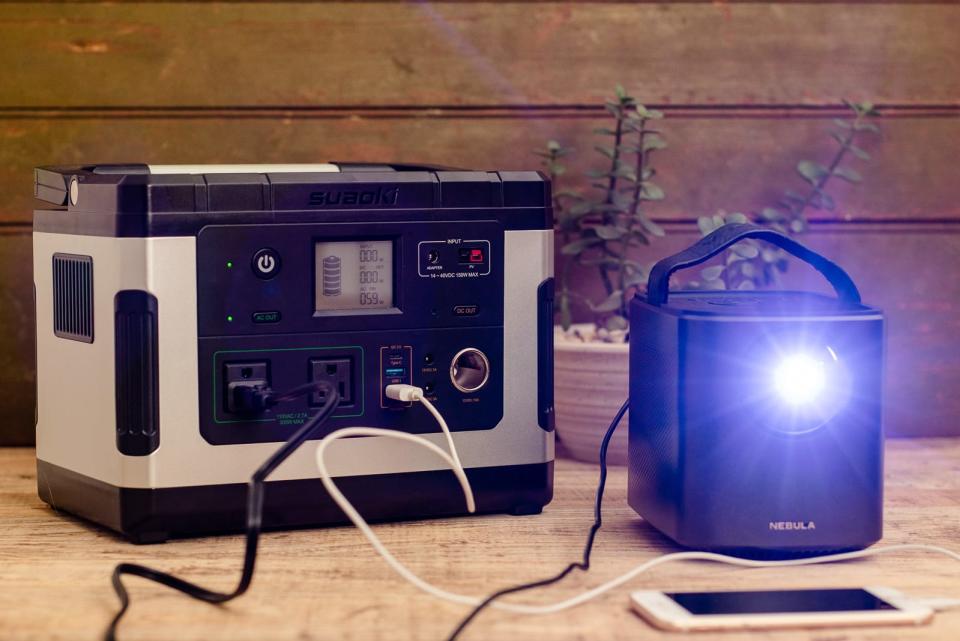
A portable power station is the best solution if you're looking to spend long periods of away from household AC outlets or you want to have backup power ready to go in case of an emergency. Portable power stations are basically large batteries in boxes with standard AC outlets attached, and they're much bigger, heavier, more powerful, and generally more rugged than our USB power bank or portable laptop charger recommendations. That gives them more versatility for outdoor activities like powering a campsite, screening a movie in your backyard, or staging a scenic photoshoot. In an emergency, they offer some major advantages over portable generators despite not being as powerful. Power stations are silent and emission-free, which means you can use them safely inside a house during a blackout. And since there's no motor, there's no need to keep gas handy or perform the oil changes or other minor maintenance a combustion engine requires.
Roughly the size of a standard plastic milk crate and weighing up to 50 pounds, you're probably not going to be carrying one of these around in a backpack or briefcase. But you can charge the power station overnight (it will take 12 to 24 hours to charge most power stations from empty to full) from a wall outlet, pack it into a trunk with the rest of your gear, and bring it with you—keeping your phone, laptop, electric grill, projector, GPS unit, electronic medical device, breast pump, drone, or more powered for hours at a time. And portable power stations usually offer other output options in addition to AC and USB—like DC and car ports—to support a wider range of devices.
Even though a high wattage portable power station can be a great backup in an emergency, it does have limitations that a gas generator will not have. A power station won't be able to keep large appliances like refrigerators powered, and anything that generates heat will likely overload it or drain the battery too fast to be useful. Space heaters and hair dryers can be plugged into a high-quality generator but should otherwise only be plugged into an indoor wall outlet.
If you plan to travel, keep in mind that in most cases, portable power stations have to travel by ground. The FAA won't let you bring a spare battery that's rated for more than 160 watt-hours in a carry-on or checked bag, so don't plan to fly with any of our portable power station picks.
How we picked
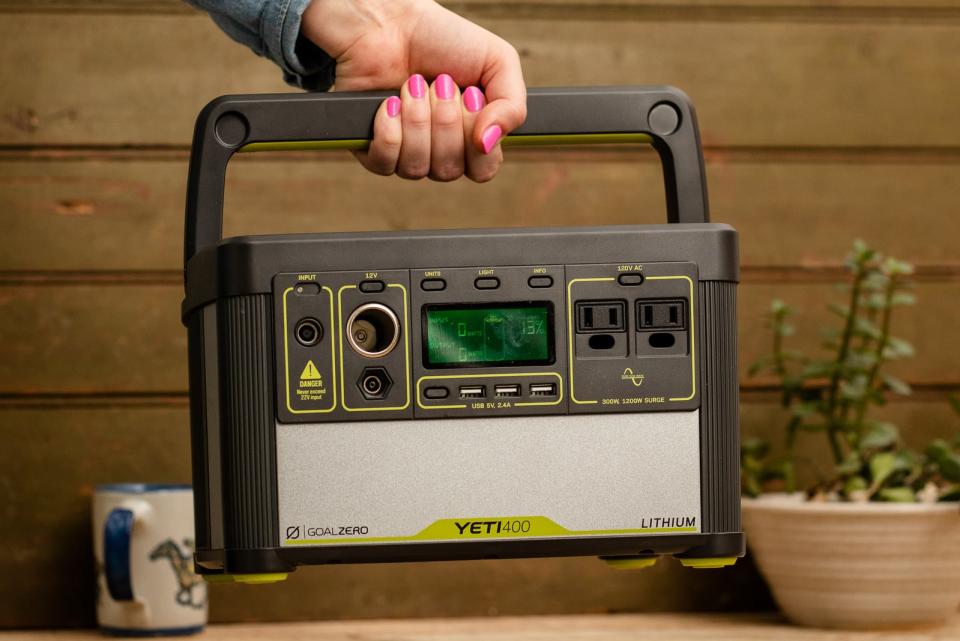
To find the most popular portable power stations on the market, we scanned the top results on Amazon, Google Shopping, and major retailers like Home Depot, REI, and Walmart. We also considered models recommended by editorial outlets like Business Insider, Pro Tool Reviews, and Lifewire.
We recorded a variety of features and specifications for each model we found and narrowed our search based on these requirements:
An output rating of at least 200 watts: To separate the portable power stations from their smaller, less powerful counterparts—USB power banks and portable laptop chargers—we required each model to be rated for at least 200 watts. Lower outputs are fine for charging phones and most other electronics, but if you want to charge a few devices at a time (especially if one or more are high-powered devices) you're going to need 200 watts or more.
A battery capacity of at least 300 watt-hours: A watt-hour is literally the measure of watts per hour, so a battery with a capacity of 300 watt-hours is the equivalent of running a 300-watt device for one hour. (For a variety of reasons, less than 100 percent of a battery's designed capacity is actually available for use.) Put another way, that's like running a 60-watt device—like a MacBook Pro, portable mini projector, or tabletop fan—for five hours. Though all power stations will have a battery meter onboard so you can see how much charge you have left, we preferred displays that offered an estimated percentage of charge over more vague displays that consisted of just a few line segments.
A maximum weight of 50 pounds: Most power stations are too big and heavy to carry on foot for long distances, but even so we set a weight limit at 50 pounds. Anything heavier than that can be hard to load and unload from a car or carry around a house in a blackout.
Rugged and portable design: We noted the materials used on the exterior, as well as any extra features like wheels or handles. Some sort of handle is a necessity to lift something this bulky. And since in some cases you're going to be using these outdoors—in a backyard or campsite—and moving them around quite a bit, we wanted them to be resistant to scuffs and scratches.
At least one AC outlet: A single AC outlet is a bare-minimum requirement, since the majority of gadgets—from desk lamps to essential oil diffusers to baby monitors—run on AC power. None of our USB power bank picks have an AC outlet, and our favorite portable laptop chargers have just one that can only power lower-wattage gear. Although we considered some models with a single AC outlet for this guide, every model that we ended up testing has two, allowing you to plug in two AC-powered devices at the same time.
At least two fast-charging USB-A ports: Any USB-A port worth its salt should support 2-amp (10-watt) charging or higher. Anything less and you'll notice just how slow your phone, tablet, and other devices charge up. Some USB-A ports also have faster Quick Charge capabilities, which we preferred but didn't require. These ports are handy so you don't have to occupy an entire AC outlet just to charge a small device like your phone, tablet, or portable Bluetooth speaker.
At least one USB-C, DC, and/or car port: We didn't require each model to have all three, but we preferred those with one or more USB-C, DC, or 12 V car (what my parents, former smokers, incorrectly call "the cigarette lighter") ports.

Charges from an AC wall outlet: At minimum, we required that each model be chargeable via an AC wall outlet since USB-only charging is much too slow for batteries so big. Some portable power stations can be charged via car ports or solar attachments, which are a nice bonus, especially if you'll be off the grid for more than a couple days.
Contains a pure sine-wave inverter: A battery's sine-wave inverter turns its direct current (DC) power into alternating current (AC) power, which is needed to power most devices. We required each model to contain a pure sine-wave inverter, which produces electrical waveforms as clear and smooth as the AC power coming out of any wall outlet. Modified sine-wave (MSW) inverters, like the ones found in our favorite portable laptop chargers, are generally less expensive but produce choppier waveforms. These are generally fine for charging other devices or running most devices with a power brick on the cord, but they shouldn't be used to run anything with a powerful motor. MSW inverters can cause inconsistent speeds, heat buildup, or damage to appliances like corded drills, vacuums, and blenders. By requiring our picks to have pure sine-wave inverters, our aim was to expand the range of devices you can safely plug into them.
At least a one-year warranty: This is not an everyday-use kind of device. A one-year warranty ensures that you actually get to use the thing before its warranty expires. We also took brand reputation into account and read online customer reviews to try to avoid models that will break or die right after the warranty is up. No battery lasts forever, and the capacity will usually diminish after the first year, but these should keep working well after the warranty has run out.
Readily available customer support: We contacted each company anonymously to gauge how difficult it would be to get in touch with someone should a problem arise.
Good value: Instead of setting a flat price cap, we looked at the ratio of capacity (watt-hours) per dollar. While prices can fluctuate, this helped us quantify the "bang for your buck" factor using hard data.
Taking all this into consideration, we ended up with a shortlist of five models for testing: the EcoFlow River, the Goal Zero Yeti 400, the Goal Zero Yeti 1000, the Goal Zero Yeti 1400 WiFi, and the Suaoki G500.
How we tested
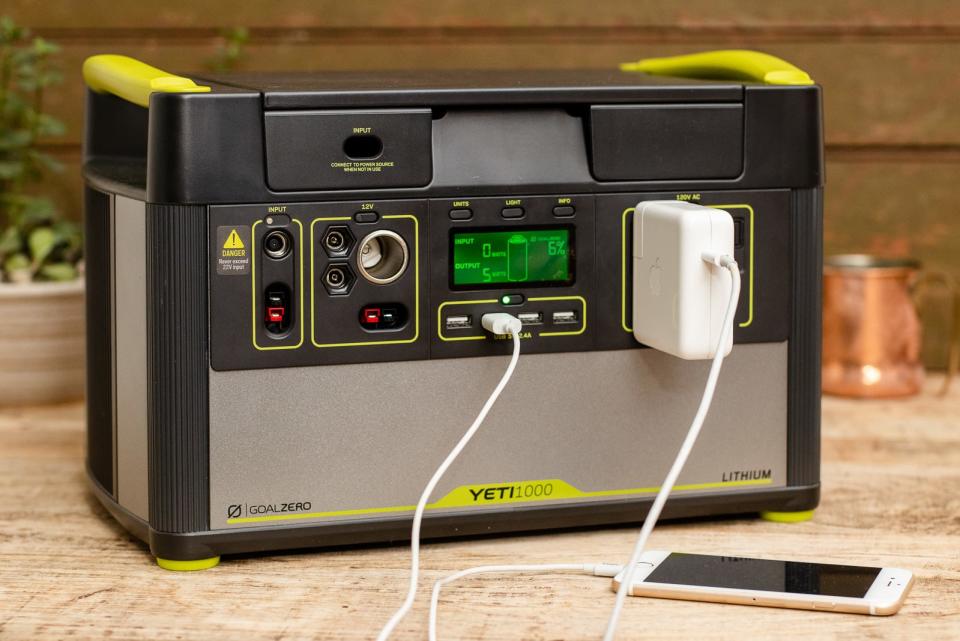
We spent 35 hours testing all five power stations, stacked precariously in a tiny Brooklyn apartment. We tested the performance of each model in a few key areas, including:
Peak power output (watts): We turned on the power station and its AC outlet, plugged in a Kill A Watt power meter, and then plugged in 50-watt halogen bulbs into an array of 10 light-bulb sockets (one by one, recording the measured increase in wattage each time) until the power station overloaded and turned off. If all 10 bulbs weren't enough to overload the power station, we replaced the array with our favorite surge protector and added fans, lamps, and other appliances until it cried uncle. For some of the more robust power stations we tested, after every other combination of appliances failed to overload them, we plugged in a power-hungry space heater. (We did so only with a fire extinguisher within arm's reach, and we do not recommend trying this at home. Electronics with an open-heating element—hair dryers, space heaters, electric kettles, and the like—should always be plugged straight into a wall outlet, as they can quickly overheat and catch fire when plugged into an extension cord, surge protector, or portable power station.)
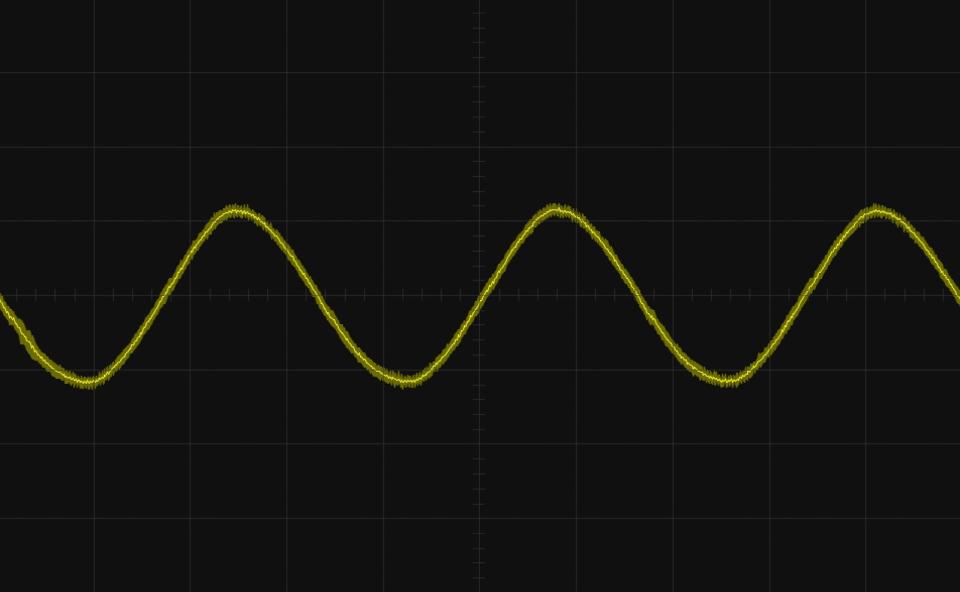
Battery capacity and run time (watt-hours): We turned on the power station and its AC outlet, plugged in a Kill A Watt power meter, plugged a 70-watt room fan (our runner-up pick) into the power meter, and let the fan run on high until the power station died. We recorded the total watt-hours it had measured and the number of hours that elapsed between fully charged and fully dead.
Look and feel: Inherent to the testing process, we handled each power station quite a bit. We also made a point to pick them up and haul them around from room to room and inspect every inch of their outer surfaces. Some of them were so heavy and bulky that we had to hire TaskRabbit assistance to transport two at a time from Brooklyn (where we did our testing) to our offices in Manhattan instead of lugging them on the subway.

Electrical and inverter quality: We used a BitScope digital oscilloscope to visualize the electrical waveforms of each power station. Since each model we tested contains a pure sine-wave inverter, their waveforms should be as clear and smooth as those from a wall outlet to ensure that your devices can run efficiently.
Our pick: Goal Zero Yeti 1000

The Goal Zero Yeti 1000 is the best portable power station for people who need hours of off-the-grid power. It offers the most bang for your buck—or, rather, watt-hours per dollar—than any other model we tested, as well as a rugged design and informative interface.
Other than the considerably more expensive Yeti 1400 WiFi, the Yeti 1000 had the highest measured output (1,540 watts) and rated capacity (1,045 watt-hours) of the models we tested. In the output test, we were able to plug in an air conditioner, two room fans, a desk lamp, a light-therapy lamp, a hair dryer set to cool, and a space heater on low before the Yeti 1000 finally shut down.
To test the maximum AC output of each portable power station, we plugged in a Kill A Watt power meter and various electronic devices (one by one, recording the measured increase in wattage each time) until the power station overloaded and shut itself down.

It also had one of the longest run times—again, second only to the Yeti 1400 WiFi. In our testing, the Yeti 1000 managed to keep a 70-watt room fan—similar wattage to a MacBook Pro, a small projector, or a CPAP device to treat sleep apnea—running for 7.5 hours. This is roughly comparable to charging several low-power devices, so you could go on a hike and leave a mix of devices charging—a spare GPS unit, portable speaker, rechargeable lantern, and other small gadgets—and have them fully powered up when you get back.
We were able to plug in an air conditioner, two room fans, a desk lamp, a light-therapy lamp, a hair dryer set to cool, and a space heater on low before the Yeti 1000 finally shut down.
In terms of looks, the Yeti 1000 is simple and utilitarian. It lack the River's sleek curves, but it's much nicer to look at and use than the clunky Suaoki model. It feels sturdily built and durable, with a hard-plastic exterior that seems pretty resistant to scratches and scuffs. The little screen on the front of the unit provides a lot of useful information—what percentage the battery is charged, the estimated number of hours remaining, and the input and output in watts—which we really appreciated. (Imagine how often you check the percentage of your phone's battery and then apply that to all of your essential devices when unlimited power isn't readily available.) Another nice feature is the ability to turn off individual ports as well as the display screen when they're not in use. So if you're just charging a couple phones, for example, you can leave the USB ports powered on and switch off the other ports. Tiny green lights illuminate above each cluster of ports, clearly telling you if those ports are on or off. Like everything made by Goal Zero, the Yeti 1000 has a green-and-gray color scheme—hopefully you like chartreuse.
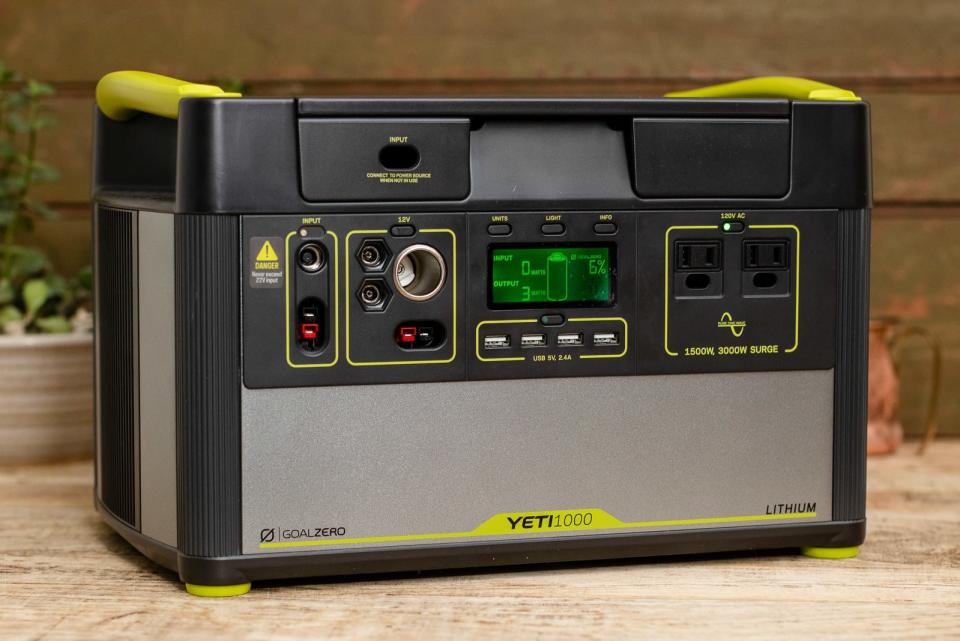
The Yeti 1000 has two AC outlets and four high-amp USB ports, doubling our minimum requirements on both counts. It also has two DC ports—although, aside from this Goal Zero lantern, it's tough to find many devices that charge from a 6 mm barrel-connector jack—and a 12-volt car port for charging small devices with an adapter. That covers pretty much every type of port you could want other than USB-C. The EcoFlow River and Yeti 1400 WiFi have two USB-C ports each, which are a great bonus—especially as USB-C can charge newer phones and tablets faster and is becoming increasingly common—but not a required trait. Plus, you have the option to charge the Yeti 1000 via AC from a wall outlet, or (if you buy a separate solar attachment, which takes about 20-40 hours to charge the Yeti 1000) it can be charged by the sun's rays.
The Yeti 1000's 12-month warranty isn't stellar, but it's also not dramatically shorter than EcoFlow's 18-month warranty. Whether under warranty or not, though, we were impressed with Goal Zero's customer support. We found the phone number with a simple Google search, and when we called it anonymously, an employee answered right away and was able to answer our basic but technical questions. The employee also gave us an unsolicited tip, recommending that people keep the unit plugged in at all times, as some amount of power will drain out when it's not in use. This also ensures that the power station is always fully charged when you need it—which is important, since it takes about a full day to charge it up completely. They also said to drain the battery down to about 50 percent at least once every two to three months, which is supposed to improve the longevity of the battery. No battery lasts forever, but if you follow some basic rules of thumb—store them at room temperature, avoid letting them die completely, and so on—batteries of this capacity should last a few years or more.
The Yeti wall chargers—the part that plugs into the wall—have an ungrounded, two-prong plug. We usually expect to see three-prong plugs on a power cord and brick like this because the extra prong (the bottom one) reduces the risk of electrocution and fires. But when we asked a Goal Zero engineer about this, they told us they went with a two-prong plug because the power brick is all plastic and will not conduct electricity.
Flaws but not dealbreakers
The one drawback with the Yeti 1000 is its size. It measures 10.1 by 15.3 by 9.3 inches and weighs 40 pounds. That's like carrying a milk crate filled with 4 gallons of milk or a full case of glass-bottled beer. (Yes, the writer of this guide did grow up in Wisconsin; why do you ask?) We felt that the extra bulk was a reasonable trade-off for more power, though, since most of the time it should be sitting in a closet, basement, or garage (when not in use) and transported by car.
Budget pick: EcoFlow River
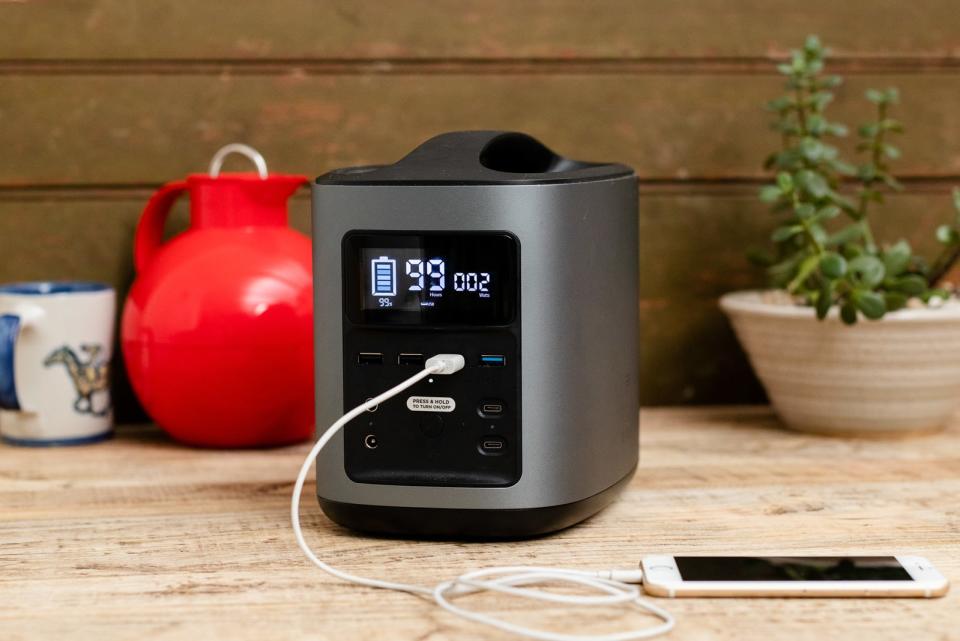
If the Yeti 1000 is out of your price range and you can get by with significantly less power, you should get the EcoFlow River. It's much less powerful than the Yeti 1000, but it's also less expensive, smaller, and lighter, and it offers the same input/output port options.
The River had the lowest maximum output out of the five models we tested—332 watts versus 1,540 watts on the pricier Yeti 1000. That's fine for basics like lights, fans, TVs, and even a modem and router during a blackout, but it won't be enough to keep refrigerators or air conditioners going. It still packs more than three times as much as power as our favorite power banks and portable laptop chargers, though, making it much more versatile.
Depending on how you plan to use your portable power station—specifically, the wattage ratings of your devices and how long you plan to run them—the 320 watt-hours of capacity might be plenty of power for a picnic, short camping trip, or in case of an emergency or shorter blackout. For example, the River was able to keep a 70-watt room fan running for 3.5 hours in our testing.
The River's biggest improvement over the Yeti 1000 is size. It weighs only 11 pounds (remember, the Yeti weighs a whopping 40 pounds) and measures 9.8 by 6.3 by 8.2 inches. That's more like carrying around a small cooler full of beer, rather than a full case. It also has a nice, curvaceous shape and a solid, grippy handle on top that makes it easy to tote around.
In terms of port options, the River has everything the Yeti 1000 has and more. It also offers two AC ports and four USB-A ports—two of which are quick-charge compatible. It has two USB-C ports, which is nice if you want to charge a newer phone like the iPhone X at top speeds or connect a USB-C-powered device like a MacBook Pro. The River also has two DC ports and a car port, and it can be charged from a wall outlet, a car's charging port, or (if you buy the optional attachments) via solar. Each port is well labeled, and the screen on the front clearly shows the battery percentage, the output wattage, and the estimated number of hours of run-time remaining.
The River has a decent, 18-month warranty, which gives you some extra time to make sure you don't have a defective unit. EcoFlow doesn't offer customer support by phone, which we'd prefer, but when we emailed the company anonymously, we heard back within a day.
The River costs a fraction of the price of the Yeti 1000—about $600 at the time of this writing versus about $1,300. And if you look at the ratio of watt-hours per dollar, the River isn't too far behind, giving you 1.8 watt-hours per dollar compared to the 2 watt-hours per dollar boasted by the Yeti 1000. So, if having a really high output isn't that important to you, you can save a lot of money by getting the River.
Upgrade pick: Goal Zero Yeti 1400 WiFi
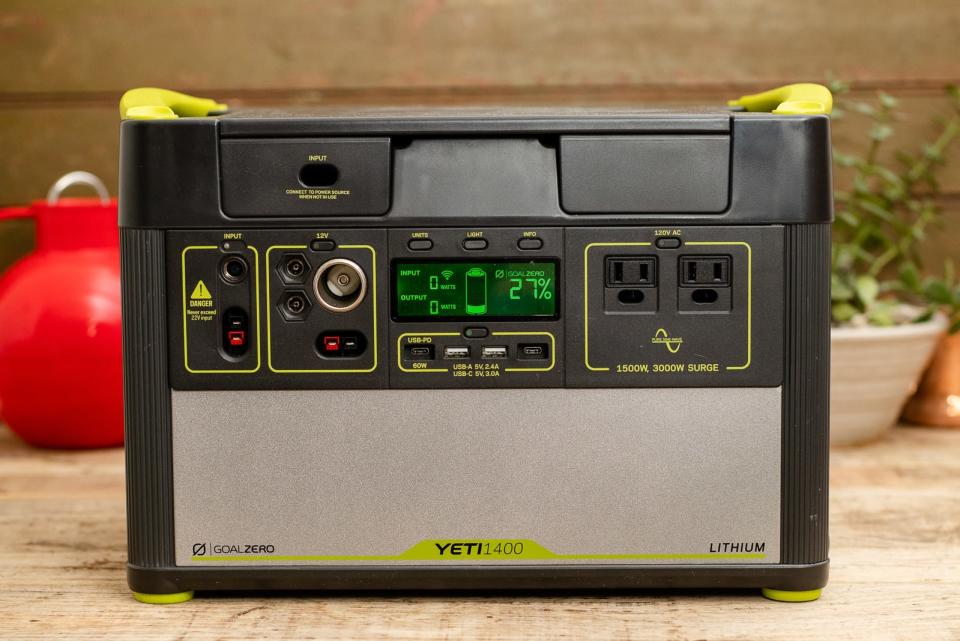
If you need even more power than the Yeti 1000 pick provides, you should get the Goal Zero Yeti 1400 WiFi. It's by far the most powerful model we tested, but it's also a lot pricier, bigger, and heavier. This is a good fit for someone who's planning to travel by car—to a campsite, music festival, or deep in the wilderness—or shelter in place following a disaster.
With a maximum output of 1,700 watts, the Yeti 1400 WiFi performed as well as any model we tested. Before it finally overloaded and shut itself down, we were able to plug in an air conditioner, a space heater set to low, two room fans on high, a desk lamp, a light-therapy lamp, and 10 halogen bulbs into it simultaneously. Its capacity is almost double that of the smaller Yeti 1000, too, measuring 1,080 watt-hours compared to 750 watt-hours. When we left our 70-watt room fan plugged into the Yeti 1400 WiFi, it ran for 10.5 hours—about 3 hours longer than the Yeti 1000 kept it running. This is impressive, and it's necessary if you want to make sure your power station won't run out of power in the middle of the night—for example, if you're running a critical medical device like a CPAP for sleep apnea.
As much as we complained about the size and weight of the Yeti 1000 (10.1 by 15.3 by 9.3 inches and 40 pounds, respectively), the Yeti 1400 WiFi is even bigger and heavier. Measuring 10.1 by 15.3 by 10.4 inches and weighing almost 44 pounds, it's pretty much a large-scale replica of the Yeti 1000, and it's the heaviest model we tested. The only models we considered for testing that weigh more—the 57-pound Strongway Portable Power System, the 103-pound Goal Zero Yeti 1250, and 109-pound Kohler enCUBE1.8—were ruled out due to their low output ratings and limited port options. As the writer of this guide, a small-framed person who hasn't lifted weights since high-school gym class, I had a hard time lifting the Yeti 1400 WiFi from the floor onto a coffee table. (For the record, my roommate, who does work out, broke into a sweat carrying it, too.) So while it is technically portable, and the handles on either side help a lot, you shouldn't plan to take it on your next backpacking trip.
Like the Yeti 1000, the Yeti 1400 WiFi has a clean, rugged design. It has the same informative display, clearly labeled ports, and little LEDs that show which ports are turned on. Unfortunately, just like the 1000, the part of the charger that plugs into the wall outlet is a two-prong plug. We'd rather that it had a third prong to keep electricity grounded, which is safer.
Another thing we didn't love: the Yeti 1400 WiFi's so-called Wi-Fi connectivity. If you download the Goal Zero app to your phone and both devices are on the same network, you can use it to check the battery levels and switch the output ports on and off—all things that you can do by walking over to the power station and looking at it. You can also use the app to update firmware, which is a nice benefit, and Goal Zero says it's added a direct-connect option that allows the app to work without a Wi-Fi network and notifications that tell you things like when the battery is fully charged or low, or if a port is overloaded. These are helpful improvements, but we still don't think it's worth paying a premium for them alone.
The Yeti 1400 WiFi has two AC ports, two DC ports, and one car port, just like the Yeti 1000. We're also happy to see that, instead of putting in four USB-A ports like the Yeti 1000, Goal Zero gave the Yeti 1400 WiFi two USB-A ports and two USB-C ports—allowing you to charge newer phones and other devices at top speeds. One of those USB-C ports also supports USB Power Delivery, which transfers the maximum amount of power (up to 100 watts) to compatible devices including an increasing number of laptops. That frees up the AC outlets for other gear that needs them.
Like with the Yeti 1000, the Yeti 1400 WiFi meets our basic requirement of a one-year warranty, and we had a good experience talking to Goal Zero's support staff.
Aside from the Suaoki G500, which we discuss more in the Competition section, the Yeti 1400 WiFi gives you the lowest dollar value of any model we tested. For every dollar you spend, you get just 1.7 watt-hours of use, compared to the 2 watt-hours per dollar you get from the Yeti 1000.
The competition
This one gave the EcoFlow River a run for its money in terms of performance, achieving a slightly higher maximum output (444 watts) and capacity (330 watt-hours) and tying its 3.5-hour run time. But it's bigger, it's heavier, and it has a clunkier design overall. Plus, it has one fewer USB-A port and no USB-C ports.
This model looks like a cheap knockoff of the Yeti 400, and it very well might be. The material feels chintzier, its handle is flimsier, and the screen doesn't tell you the battery level. Rather, a light on the charging brick turns green and the battery symbol on the screen stops blinking when it's fully charged. The G500's output, capacity, and run time were a little better than that of the Yeti 400 and the EcoFlow River—479 watts, 430 watt-hours, and 4.5 hours, respectively—but not enough to justify these other flaws. Plus, we had a hard time getting in touch with the company, and when we tried emailing customer support anonymously (no phone number is listed on the website) we got no response.
This guide may have been updated by Wirecutter. To see the current recommendation, please go here.
When readers choose to buy Wirecutter's independently chosen editorial picks, Wirecutter and Engadget may earn affiliate commissions.
